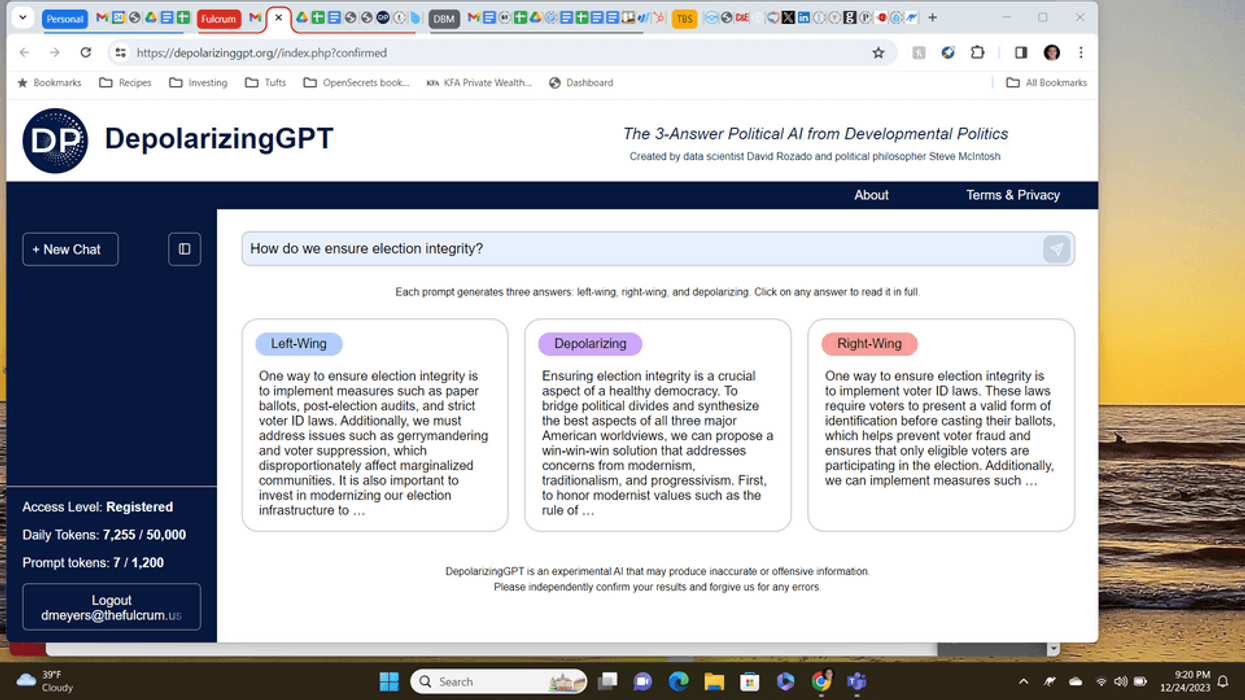Rozado is an associate professor of computer science at Te Pūkenga - The New Zealand Institute of Skills and Technology. He is also a faculty fellow at Heterodox Academy's Center for Academic Pluralism. McIntosh is the author of “Developmental Politics” (Paragon House 2020) and coauthor of “Conscious Leadership” (Penguin 2020). He is cofounder and lead philosopher at the Institute for Cultural Evolution.
Amid countless reports of how social media is exacerbating political polarization, many commentators worry that artificial intelligence will come to have a similarly corrosive effect on American culture. In response to these concerns, an innovative new tool has been developed to leverage AI technology to reduce polarization: Meet DepolarizingGPT, a political chatbot designed to tackle polarization head on.
Unlike other AI models, DepolarizingGPT is focused specifically on political issues. It provides three responses to every prompt: one from a left-wing perspective, one from a right-wing perspective and a third response from a depolarizing or “integrating” viewpoint. We created this three-answer model to ameliorate political and cultural polarization by demonstrating a developmental approach to politics, one that synthesizes responsible perspectives from across the political spectrum.
The idea is to combine three models — LeftwingGPT, RightwingGPT and DepolarizingGPT — into one single system. Users are exposed to three perspectives simultaneously, moving beyond the echo chambers that often reinforce entrenched biases. Existing AIs, such as OpenAI's ChatGPT, claim to be unbiased, but this claim has been shown to be false. So rather than denying its bias, which always exists, DepolarizingGPT's three-answer model offers responsible perspectives from left, right and integrated positions. The goal is to foster a more diverse, nuanced understanding of differing political views, and to reduce the tendency to vilify the other side.
DepolarizingGPT's left-wing responses have been fine-tuned (within the fair-use provisions of copyright law) by using content from left-leaning publications such as The Atlantic, The New Yorker and The New Republic, and from numerous left-wing writers such as Bill McKibben and Joseph Stiglitz. The model's right-wing responses have been fine-tuned with content from publications such as National Review, The American Conservative and City Journal, as well as from numerous right-leaning writers such as Roger Scruton and Thomas Sowell. And the model's depolarizing responses have been fine-tuned with content from the inclusive political philosophy of the Institute for Cultural Evolution.
The model's depolarizing answers attempt to transcend centrism and avoid simply splitting the difference between left and right. When at their best, these depolarizing responses demonstrate a kind of "higher ground" that goes beyond the familiar left-right political spectrum. Admittedly, however, some of the model's depolarizing responses inevitably fall short of this goal.
This project stems from David Rozado’s academic research, which revealed the inherent left-wing political bias of ChatGPT. To address this issue, Rozado created an experimental AI model with an opposite kind of right-wing bias. His work attracted attention from The New York Times, Wired and Fox News. The intent in demonstrating the political bias of supposedly neutral AIs was to help prevent artificial intelligence from becoming just another front in the culture war.
After reading about Rozado's work, Steve McIntosh proposed that the two team up to create an AI model that could actually help reduce political polarization. Since cofounding the Institute for Cultural Evolution in 2013, McIntosh has been working to overcome hyperpolarization by showing how America can grow into a better version of itself. His institute offers a platform of "win-win-win" policy proposals, which integrate the values of all three major American worldviews: progressive, modernist and traditional. And this same method of integrating values used to build the institute's policy platform is now programmed into DepolarizingGPT's three-answer political chatbot.
Within conventional politics, people are often faced with win-lose propositions. But by focusing on the bedrock values that most people already share, it becomes possible to discover something closer to a win-win-win solution, even if such a solution does not completely satisfy all parties. This win-win-win strategy aims to accommodate the concerns of all sides, not just to get its way, but to make authentic progress through cultural evolution.
By synthesizing values from across the political spectrum, artificial intelligence promises to help American society grow out of its currently dysfunctional political condition.




















A deep look at how "All in the Family" remains a striking mirror of American politics, class tensions, and cultural manipulation—proving its relevance decades later.
All in This American Family
There are a few shows that have aged as eerily well as All in the Family.
It’s not just that it’s still funny and has the feel not of a sit-com, but of unpretentious, working-class theatre. It’s that, decades later, it remains one of the clearest windows into the American psyche. Archie Bunker’s living room has been, as it were, a small stage on which the country has been working through the same contradictions, anxieties, and unresolved traumas that still shape our politics today. The manipulation of the working class, the pitting of neighbor against neighbor, the scapegoating of the vulnerable, the quiet cruelties baked into everyday life—all of it is still here with us. We like to reassure ourselves that we’ve progressed since the early 1970s, but watching the show now forces an unsettling recognition: The structural forces that shaped Archie’s world have barely budged. The same tactics of distraction and division deployed by elites back then are still deployed now, except more efficiently, more sleekly.
Archie himself is the perfect vessel for this continuity. He is bigoted, blustery, reactive, but he is also wounded, anxious, and constantly misled by forces above and beyond him. Norman Lear created Archie not as a monster to be hated (Lear’s genius was to make Archie lovable despite his loathsome stands), but as a man trapped by the political economy of his era: A union worker who feels his country slipping away, yet cannot see the hands that are actually moving it. His anger leaks sideways, onto immigrants, women, “hippies,” and anyone with less power than he has. The real villains—the wealthy, the connected, the manufacturers of grievance—remain safely and comfortably offscreen. That’s part of the show’s key insight: It reveals how elites thrive by making sure working people turn their frustrations against each other rather than upward.
Edith, often dismissed as naive or scatterbrained, functions as the show’s quiet moral center. Her compassion exposes the emotional void in Archie’s worldview and, in doing so, highlights the costs of the divisions that powerful interests cultivate. Meanwhile, Mike the “Meathead” represents a generation trying to break free from those divisions but often trapped in its own loud self-righteousness. Their clashes are not just family arguments but collisions between competing visions of America’s future. And those visions, tellingly, have yet to resolve themselves.
The political context of the show only sharpens its relevance. Premiering in 1971, All in the Family emerged during the Nixon years, when the “Silent Majority” strategy was weaponizing racial resentment, cultural panic, and working-class anxiety to cement power. Archie was a fictional embodiment of the very demographic Nixon sought to mobilize and manipulate. The show exposed, often bluntly, how economic insecurity was being rerouted into cultural hostility. Watching the show today, it’s impossible to miss how closely that logic mirrors the present, from right-wing media ecosystems to politicians who openly rely on stoking grievances rather than addressing root causes.
What makes the show unsettling today is that its satire feels less like a relic and more like a mirror. The demagogic impulses it spotlighted have simply found new platforms. The working-class anger it dramatized has been harvested by political operatives who, like their 1970s predecessors, depend on division to maintain power. The very cultural debates that fueled Archie’s tirades — about immigration, gender roles, race, and national identity—are still being used as tools to distract from wealth concentration and political manipulation.
If anything, the divisions are sharper now because the mechanisms of manipulation are more sophisticated, for much has been learned by The Machine. The same emotional raw material Lear mined for comedy is now algorithmically optimized for outrage. The same social fractures that played out around Archie’s kitchen table now play out on a scale he couldn’t have imagined. But the underlying dynamics haven’t changed at all.
That is why All in the Family feels so contemporary. The country Lear dissected never healed or meaningfully evolved: It simply changed wardrobe. The tensions, prejudices, and insecurities remain, not because individuals failed to grow but because the economic and political forces that thrive on division have only become more entrenched. Until we confront the political economy that kept Archie and Michael locked in an endless loop of circular bickering, the show will remain painfully relevant for another fifty years.
Ahmed Bouzid is the co-founder of The True Representation Movement.